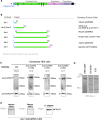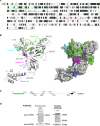Calpain-5 Expression in the Retina Localizes to Photoreceptor Synapses
- PMID: 27152965
- PMCID: PMC4868102
- DOI: 10.1167/iovs.15-18680
Calpain-5 Expression in the Retina Localizes to Photoreceptor Synapses
Abstract
Purpose: We characterize calpain-5 (CAPN5) expression in retinal and neuronal subcellular compartments.
Methods: CAPN5 gene variants were classified using the exome variant server, and RNA-sequencing was used to compare expression of CAPN5 mRNA in the mouse and human retina and in retinoblastoma cells. Expression of CAPN5 protein was ascertained in humans and mice in silico, in mouse retina by immunohistochemistry, and in neuronal cancer cell lines and fractionated central nervous system tissue extracts by Western analysis with eight antibodies targeting different CAPN5 regions.
Results: Most CAPN5 genetic variation occurs outside its protease core; and searches of cancer and epilepsy/autism genetic databases found no variants similar to hyperactivating retinal disease alleles. The mouse retina expressed one transcript for CAPN5 plus those of nine other calpains, similar to the human retina. In Y79 retinoblastoma cells, the level of CAPN5 transcript was very low. Immunohistochemistry detected CAPN5 expression in the inner and outer nuclear layers and at synapses in the outer plexiform layer. Western analysis of fractionated retinal extracts confirmed CAPN5 synapse localization. Western blots of fractionated brain neuronal extracts revealed distinct subcellular patterns and the potential presence of autoproteolytic CAPN5 domains.
Conclusions: CAPN5 is moderately expressed in the retina and, despite higher expression in other tissues, hyperactive disease mutants of CAPN5 only manifest as eye disease. At the cellular level, CAPN5 is expressed in several different functional compartments. CAPN5 localization at the photoreceptor synapse and with mitochondria explains the neural circuitry phenotype in human CAPN5 disease alleles.
Figures







Similar articles
-
Functional validation of a human CAPN5 exome variant by lentiviral transduction into mouse retina.Hum Mol Genet. 2014 May 15;23(10):2665-77. doi: 10.1093/hmg/ddt661. Epub 2013 Dec 30. Hum Mol Genet. 2014. PMID: 24381307 Free PMC article.
-
Capn5 Expression in the Healthy and Regenerating Zebrafish Retina.Invest Ophthalmol Vis Sci. 2018 Jul 2;59(8):3643-3654. doi: 10.1167/iovs.18-24278. Invest Ophthalmol Vis Sci. 2018. PMID: 30029251 Free PMC article.
-
CAPN5 genetic inactivation phenotype supports therapeutic inhibition trials.Hum Mutat. 2019 Dec;40(12):2377-2392. doi: 10.1002/humu.23894. Epub 2019 Aug 26. Hum Mutat. 2019. PMID: 31403230 Free PMC article.
-
Expression of developmentally defined retinal phenotypes in the histogenesis of retinoblastoma.Am J Pathol. 1992 Aug;141(2):363-75. Am J Pathol. 1992. PMID: 1386715 Free PMC article. Review.
-
Lessons from Retinoblastoma: Implications for Cancer, Development, Evolution, and Regenerative Medicine.Trends Mol Med. 2016 Oct;22(10):863-876. doi: 10.1016/j.molmed.2016.07.010. Epub 2016 Aug 23. Trends Mol Med. 2016. PMID: 27567287 Free PMC article. Review.
Cited by
-
Disturbed Presynaptic Ca2+ Signaling in Photoreceptors in the EAE Mouse Model of Multiple Sclerosis.iScience. 2020 Nov 20;23(12):101830. doi: 10.1016/j.isci.2020.101830. eCollection 2020 Dec 18. iScience. 2020. PMID: 33305185 Free PMC article.
-
Clinical and Molecular Characteristics of Mitochondrial Dysfunction in Autism Spectrum Disorder.Mol Diagn Ther. 2018 Oct;22(5):571-593. doi: 10.1007/s40291-018-0352-x. Mol Diagn Ther. 2018. PMID: 30039193 Free PMC article. Review.
-
A novel de novo CAPN5 mutation in a patient with inflammatory vitreoretinopathy, hearing loss, and developmental delay.Cold Spring Harb Mol Case Stud. 2018 Jun 1;4(3):a002519. doi: 10.1101/mcs.a002519. Print 2018 Jun. Cold Spring Harb Mol Case Stud. 2018. PMID: 29472286 Free PMC article.
-
Structural Insights into the Unique Activation Mechanisms of a Non-classical Calpain and Its Disease-Causing Variants.Cell Rep. 2020 Jan 21;30(3):881-892.e5. doi: 10.1016/j.celrep.2019.12.077. Cell Rep. 2020. PMID: 31968260 Free PMC article.
-
Comprehensive analysis of prognostic value and immune infiltration of calpains in pancreatic cancer.J Gastrointest Oncol. 2021 Dec;12(6):2600-2621. doi: 10.21037/jgo-21-705. J Gastrointest Oncol. 2021. PMID: 35070391 Free PMC article.
References
Publication types
MeSH terms
Substances
Grants and funding
LinkOut - more resources
Full Text Sources
Other Literature Sources
Molecular Biology Databases
Research Materials

